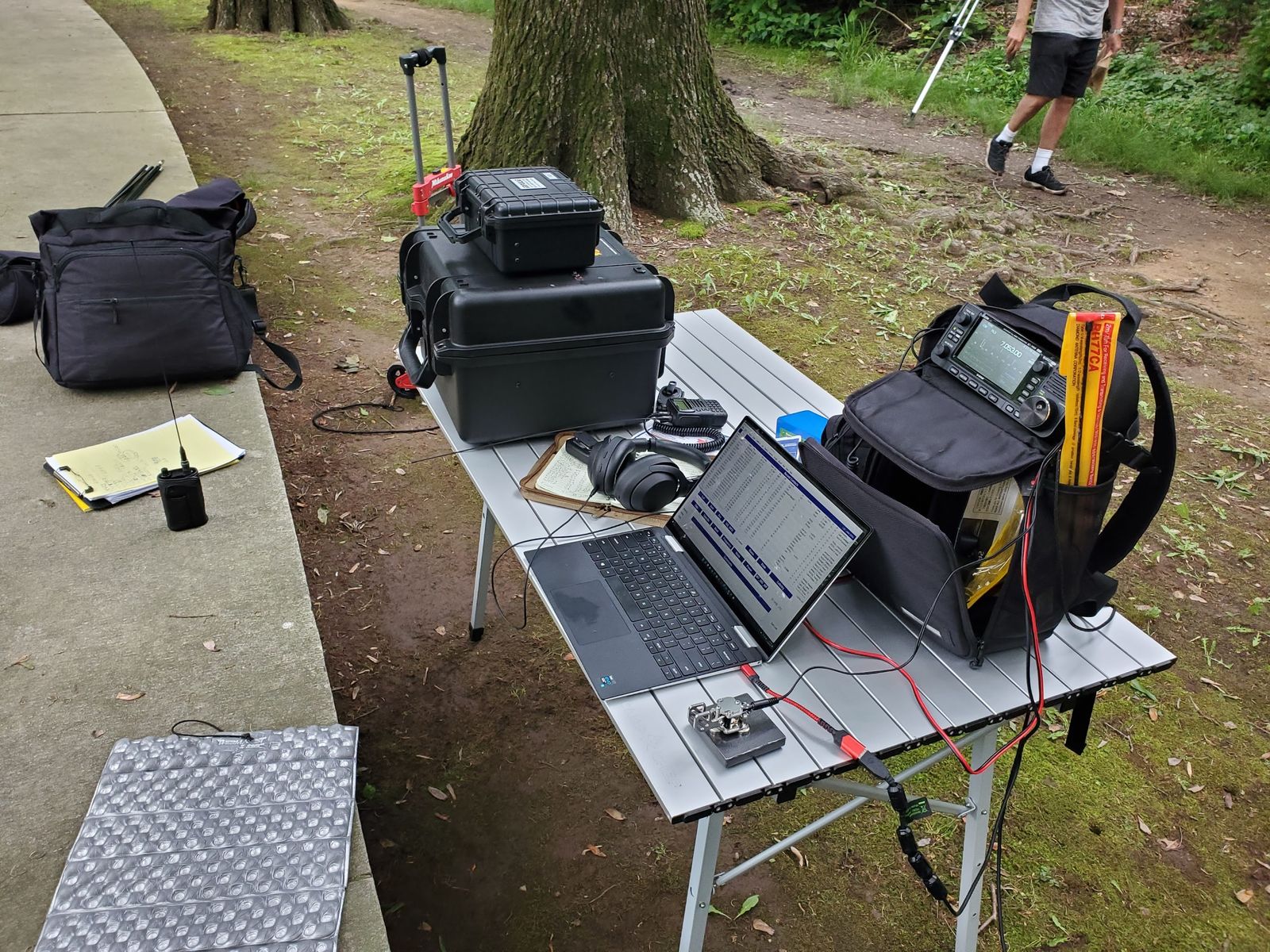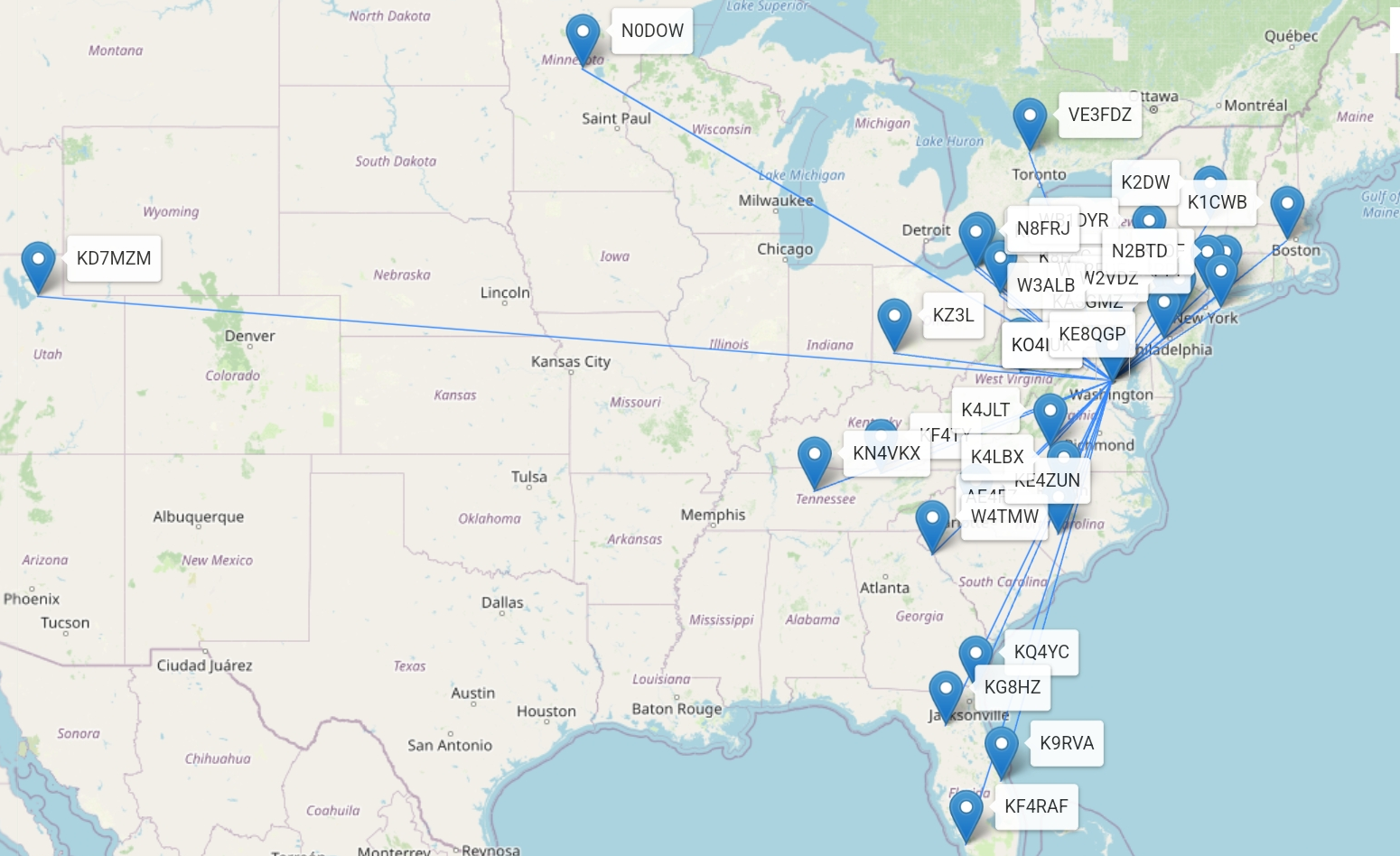POTA Activation #12 - Theodore Roosevelt Island (DC) (5/28/2022)

Getting out into the field to activate a new park is always a lot of fun. Getting to do it with a friend is even better. Gershon, KO4IUK, let me know that he had some time available on May 28, 2022, the Saturday of Memorial Day weekend. Conveniently, I was able to get out for a few hours so we decided to activate a new (to us) park -- Theodore Roosevelt Island in Washington, DC.
I have visited this park on multiple occasions. It is a often overlooked gem right in-between Georgetown and Rossyln on an island in the Potomac River. It can be accessed by bike, on foot, or on the Northbound side of the George Washington Memorial Parkway. Parking is limited, so you may have to wait for a spot to free up when there are a lot of visitors and you're visiting by car. The island is a memorial to President Theodore Roosevelt, who was instrumental in the creation of the National Park Service. The island itself is closed to vehicles and is accessed through a footbridge that crosses from Virginia over a part of the Potomac River to the island in the District of Columbia.
Once on the island there are several trails traversing the island. Some skirt the coast and offer beautiful views of the Potomac and the marshland on the island. Others climb up into the interior. A short distance from the footbridge is a striking memorial to Theodore Roosevelt with a statue that towers over an expansive plaza. Initially we tried to get an operating location near the coast since if we were to operate within 100 feet of the Potomac River, it would have been a twofer with Captain John Smith Chesapeake National Historic Trail. Unfortunately, muddy conditions and dense vegetation made that more difficult than it was worth, so we decided to set up camp on the outskirts of the memorial itself, well away from the heavily trafficked areas so as not to interfere with the enjoyment of the visitors to the memorial.
Gersohn and I had a lot of gear we brought-in together. I had my radio in my backpack, but also took my Camp Chef Mesa table and a Wren folding chair which ended up holding the matching unit for my antenna as we sat on the ledge to the memorial. I also opted for my laptop so that I could introduce Gersohn to operating with FT8. I brought the Buddistick Pro as well as my MFJ 1982 MP End Fed Half Wave antenna. I decided to use the EFHW for this activation for its frequency agility and since I was near some great trees. Gersohn brought his more high-powered setup along with his Alpha Antenna vertical and we got setup pretty quickly.

Some activations can be a real challenge on 10 W, while others just seem to come easy. This one was the latter. I set myself up on 40 m SSB, self-spotted, and I was off. My first contact was with New Jersey followed by New York, Ohio, Pennsylvania, Ontario (Canada), Connecticut, North Carolina, Tennessee, Virginia, Vest Virginia, and Massachusetts. In all, I had 21 contacts on SSB, including 3 Park to Park contacts with Ontario (Canada), Pennsylvania, and Virginia. Next I moved over to 2m and 70cm to make some calls on the calling frequencies. Unfortunately, nobody outside the park answered, but Gersohn and I made two inside-the-park Park to Park contacts for fun. Next I hopped over to 20m to do a little FT8 on the laptop and show Gersohn how it works. I made 3 Park to Park contacts with the Dominican Republic, Florida, and Ohio and also contacted Minnesota and Florida (not a park) as well.
Finally, as we were starting to wind things down I mentioned to Gersohn that I had brought my paddles for CW. I have been hunting POTA for a while from home using CW as I've been re-learning Morse code and have been having a lot of fun doing it. I looked on the spots and saw that there was one station in the entire world who activating CW at that time that I could hear, so I decided to throw my call sign out there to see if he could hear me. Turns out, he could, and pretty well at that as I got a 569 report. Unfortunately, nobody else was activating in CW, so I had nobody else to contact. Gersohn suggested I call CQ, and I explained that calling CQ was harder since instead of having all the time in the world to get the call (or get it from the spots) and only having to send and receive a signal report and location you have to decipher the calls in real-time and deal with pile-ups. But as I sat there, I realized he was right. Why not give it a go? So I found a free bit of spectrum at 7.047 MHz and started calling CQ. I had the spots up on my phone and after my first call I saw that immediately my spot updated from the Reverse Beacon Network (how cool is that?) and now I was the second person in the world activating POTA on CW.
A quick aside -- for the last few months I've been practicing my Morse code pretty much every single day. What motivated me to give it another go after learning it 32 years ago to pass my novice exam and then promptly not using it again was POTA. I set a goal for myself -- and when I set it, I wasn't sure it was one I'd be able to meet. I wanted to be able to do a complete POTA activation with CW. After getting started in POTA I found the YouTube Channel of K4SWL as well as his site QRPer.com. Thomas makes what he calls "real-time, real-life activation videos" where he shows an unedited and unvarnished look into his activations for Parks on the Air and Summits on the Air. Most of his activations are on CW (although he does SSB as well), done at QRP power levels, and I quickly got hooked on his videos. You are listening along with him to the calls coming in and can view his log book. I would listen to the code coming in and try to decipher the calls before he wrote them down (and then check my copy). Over time I came to become more comfortable with the cadence of the exchange and was able to understand more and more of what I heard. His activations are usually around 18 words per minute, but he would slow down if someone called slower. He really showed what it was to be a courteous and kind operator and watching his videos was an inspiration. My family may think I'm a bit crazy watching YouTube videos with a bunch of beeping and a steady camera angle of a radio and a notepad, but I could not get enough of it, and went deep into his back catalog and was excited for each new video. His site QRPer.com (and also the SWLing Post) is also great for his activation reports (which inspired me to do something similar here) and honest gear review for QRP rigs and equipment. Seriously, it is great stuff.
So back to the activation. Almost immediately I got a response from W8ARC in West Virginia who heard me at 579. Then came calls from Ohio, New York, Michigan, Georgia, North Carolina, Quebec (Canada), and Pennsylvania. My 10 W on the IC-705 was getting great signal reports -- the lowest was a 559 and I was getting plenty of 599s as well. In the middle of my run had a bit of a pile-up where I could hear that characteristic warble of multiple CW calls overlapping. I took a deep breath and kept my cool, extracting a character or two from the sea of tones and sending it back with a question mark. I had to have a few of the calls re-sent in that manner, and although that was my fear going in (that I'd have difficulty copying) I quickly realized it wasn't a big deal. In fact, after getting a re-send on the calls I got partials on, I got a solid copy on the second go-around and nobody had to correct my copy. Everybody was having a good time. It required my full concentration, but I was doing it. Before I knew it I looked at my log and realized I had just gotten 10 contacts from my CQ calls. A valid activation. I sent out a QRT de N2EC, took a deep breath grew a big grin -- I did it. Technically, the goal was a CW activation, and I had already made the activation on SSB, but if I removed all those other contacts, it would have still been a valid activation. I'll take it.
It isn't everyday that you get to reach a long-term goal you set for yourself. To be honest, I thought it would be a few more months before I gave it a try out in the field. Thanks to Gersohn for pushing me out of my comfort zone and for Thomas for showing me how it could be done. It was an absolute blast. With the adrenaline still running through my veins I took down my antenna, packed up my gear, and headed back to the car with Gersohn, floating on air. So much fun.

Gear used in this activation
- Icom IC-705
- MFJ 1984 MP End-Fed Half Wave Antenna
- LDG Z100 Plus
- Stainless Steel Double Paddle Morse Code Key with Magnet Base
- CW Morse Steel Base for Pocket Paddles
- RigExpert Stick Pro Antenna Analyzer
- Icom LC-192
- Bioenno 12V 6Ah LiFePO4 Battery
- Sony Headphones
- Dell XPS 13 Laptop
- Camp Chef Mesa Folding Aluminum Table
- Rite in the Rain Notebook
- Zebra DelGuard Mechanical Pencil

